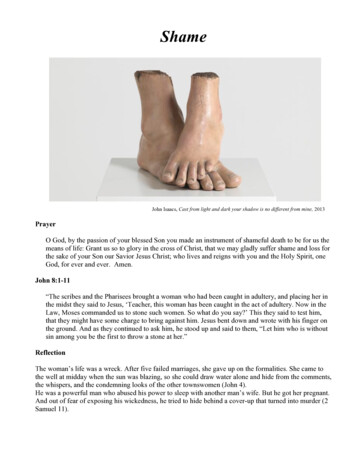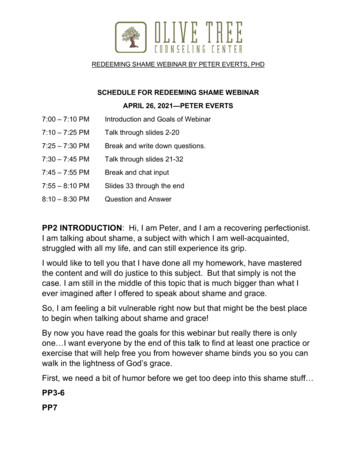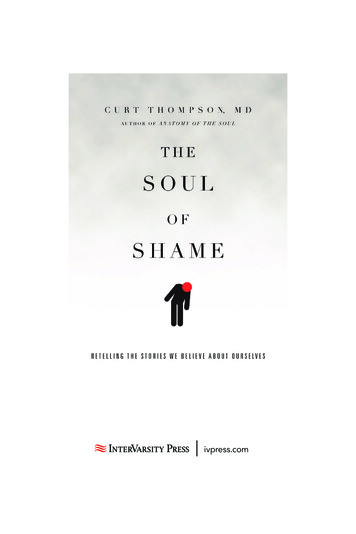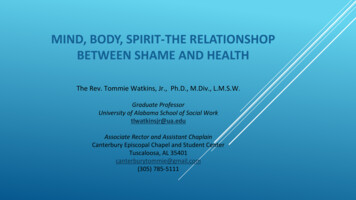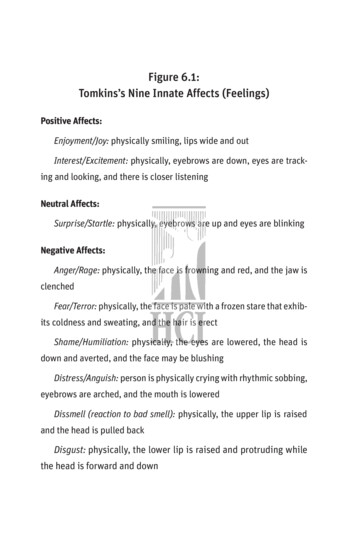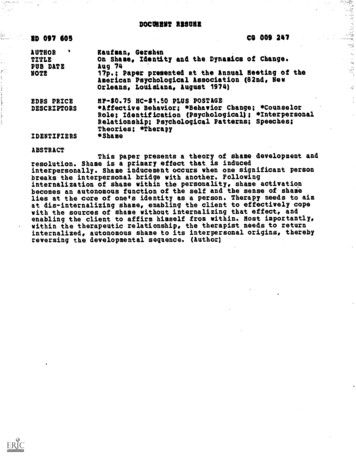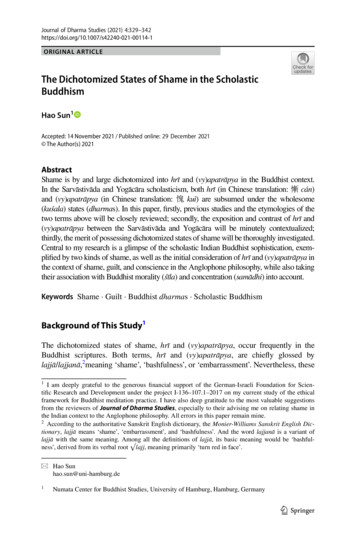
Transcription
Journal of Dharma Studies (2021) 4-1ORIGINAL ARTICLEThe Dichotomized States of Shame in the ScholasticBuddhismHao Sun1Accepted: 14 November 2021 / Published online: 29 December 2021 The Author(s) 2021AbstractShame is by and large dichotomized into hrī and (vy)apatrāpya in the Buddhist context.In the Sarvāstivāda and Yogācāra scholasticism, both hrī (in Chinese translation: 慚 cán)and (vy)apatrāpya (in Chinese translation: 愧 kuì) are subsumed under the wholesome(kuśala) states (dharmas). In this paper, firstly, previous studies and the etymologies of thetwo terms above will be closely reviewed; secondly, the exposition and contrast of hrī and(vy)apatrāpya between the Sarvāstivāda and Yogācāra will be minutely contextualized;thirdly, the merit of possessing dichotomized states of shame will be thoroughly investigated.Central to my research is a glimpse of the scholastic Indian Buddhist sophistication, exemplified by two kinds of shame, as well as the initial consideration of hrī and (vy)apatrāpya inthe context of shame, guilt, and conscience in the Anglophone philosophy, while also takingtheir association with Buddhist morality (śīla) and concentration (samādhi) into account.Keywords Shame · Guilt · Buddhist dharmas · Scholastic BuddhismBackground of This Study1The dichotomized states of shame, hrī and (vy)apatrāpya, occur frequently in theBuddhist scriptures. Both terms, hrī and (vy)apatrāpya, are chiefly glossed bylajjā/lajjanā,2meaning ‘shame’, ‘bashfulness’, or ‘embarrassment’. Nevertheless, these1I am deeply grateful to the generous financial support of the German‑Israeli Foundation for Scientific Research and Development under the project I‑136–107.1–2017 on my current study of the ethicalframework for Buddhist meditation practice. I have also deep gratitude to the most valuable suggestionsfrom the reviewers of Journal of Dharma Studies, especially to their advising me on relating shame inthe Indian context to the Anglophone philosophy. All errors in this paper remain mine.2According to the authoritative Sanskrit English dictionary, the Monier-Williams Sanskrit English Dictionary, lajjā means ‘shame’, ‘embarrassment’, and ‘bashfulness’. And the word lajjanā is a variant oflajjā with the same meaning. Among all the definitions of lajjā, its basic meaning would be ‘bashfulness’, derived from its verbal root lajj, meaning primarily ‘turn red in face’.* Hao Sunhao.sun@uni-hamburg.de1Numata Center for Buddhist Studies, University of Hamburg, Hamburg, Germany13Vol.:(0123456789)
330Journal of Dharma Studies (2021) 4:329–342two kinds of shame are almost always told apart in the scholastic Buddhism. Shameis in Sanskrit not one concept, just like its complexity and multifacetedness in theAnglophone philosophy.3 Starting from the concept of shame, the distinction of ‘guiltcultures’ and ‘shame-cultures’ was popularized specially by American anthropologists(Atkins, 1960; Benedict, 1946; Cottingham, 2013; Deigh, 1996). Studies on the shamecultures represent a growing field in this field. In one recent article, it is summarized(Cottingham, 2013) that ‘the guilt-cultures of society places great emphasis on ideasof conscience, personal accountability and liability to blame and punishment, whileshame-cultures emphasises personal status or standing, as measured in terms of publicesteem or its forfeiture’. Whether such contrast of guilt and shame is also related inthe Buddhist context is one of my major concerns in this paper. As far as I know, hrīand (vy)apatrāpya in the scholastic Buddhism are most eligible equivalent terms forcomparing to guilt and shame in the Anglophone philosophy.In Sanskrit, both hrī and (vy)apatrāpya are categorized into wholesome (kuśala)states (dharmas) in the Sarvāstivāda and Yogācāra scholasticism. The existing studies on the wholesome (kuśala) and unwholesome (akuśala) states (dharmas) in theSarvāstivāda and Yogācāra scholastic Buddhism are also relatively extensive, yethave not particularly focused on certain (pairs or sets of) these Buddhist dharmas.In fact, recent years have witnessed a growing global academic interest in providing an overall feature for the ground-breaking study of these intriguing dharmasin the framework of scholastic Buddhism. Some representative works in this fieldinclude Kuśala and Akuśala (Schmithausen, 2013), A Study of the Saṃskāra Section of Vasubandhu’s Pañcaskandhaka (Kramer, 2013), The One Hundred Elements(dharma) of Yogācāra (Saito et al., 2014), and The Seventy-five Elements (dharma)of Sarvāstivāda (Saito et al., 2018). Overall, research on Buddhist dharmas in thecontext of scholastic Buddhism has received considerable scholarly attention worldwide, and especially in the past ten years.That being said, the juxtaposition and contextualization of two kinds of shame inthe scholastic Buddhist dharmas have hitherto received scant attention by Buddhistscholars, let alone are they put under discussion in association with the shame andguilt cultures mostly interested by American scholars. It is a great pity. However, italso leaves abundant room for me to conduct this study. One might regard inquiryinto shame and its related states as weighing too heavily on mind. But for me, thediscussion and thorough study of these two Buddhist terms are not oppressive orshameful; rather, it is beneficial. In the scholastic Buddhism, hrī and (vy)apatrāpyaare indeed characterized as wholesome (kuśala) dharmas, and their antipodes,two kinds of shamelessness (āhrīkya and anapatrapā), are designated as unwholesome (akuśala). This lends support to my research. More pragmatically, two kindsof shame (hrī and apatrāpya) are credited with being conducing to attaining one3Many thanks to the kind suggestion from the reviewers of Journal of Dharma Studies, who suggestedme to read a paper (Cottingham, 2013) on the complexity of shame and its relationship to conscienceand guilt in the Anglophone philosophy. This work enables me to reach a better understanding of theseEnglish key words and revise my translation of hrī and apatrāpya in the framework of the Anglophonephilosophy.13
331Journal of Dharma Studies (2021) 4:329–342essential Buddhist meditation called samādhi,4 as illustrated in the Samāhitābhūmi(literally: The Level of Concentration) of the Yogācāra School. The passage onthe detailed account of the beneficial factors for attaining samādhi runs in theSamāhitābhūmi as follows5:What is conducive to samādhi (samādhisāṃpreya)? Such as hrī-liked shame,apatrāpya-liked shame, joy and respect (premagaurava), religious confidence and motivation (śraddhā6), right attention (yoniśomanaskāra), mindfulness and clear comprehension (smṛtisaṃprajanya), sensory restraint(indriyasaṃvara), right conduct of self-discipline (śīlasaṃvara), freedomfrom regret (avipratisāra) and so on, until pleasure (sukha) as the last one.The citation above draws our attention to the important role of two kinds of shame,as they strikingly take up the first two positions of the beneficial factors to samādhimeditation. This paramount position again justifies the importance of this study,as not only many scholars are fascinated by the shame and guilt cultures, but alsoBuddhist practitioners without academic background longing simply for meditativesilence would be very interested in this topic. Having prioritized the two kinds ofshame for the sake of samādhi meditation, the passage above truly attracts us to further consider the exact meaning and possible divergence of these two Sanskrit terms.To get a full appreciation of them, I will first turn to its definition in the authoritative Sanskrit dictionary. In A Sanskrit-English Dictionary (Monier-Williams, 1899),hrī is translated as ‘shame’, ‘modest’, ‘shyness’, and ‘timidity’; while the verbalform apa trap for (vy)apatrāpya is construed as ‘to be ashamed or bashful’. Thedefinition in the dictionary demonstrates that hrī and (vy)apatrāpya are synonyms;each denotes a state of shame. Though the juxtaposition of two kinds of shame isnot explicitly clarified, we can somehow get the impression from the Monier-Williams Sanskrit English Dictionary that unlike apatrāpya, hrī is the kind of shame,largely related to (1) one’s moral integrity, as the definition ‘modest’ conveys and (2)embarrassment, as ‘shyness’ and ‘timidity’ suggest. According to the studies conducted by experts on the nuanced contrast of guilt and shame (Atkins, 1960; Cottingham, 2013; Dodds, 1951), ‘guilt’ system stresses in personal responsibility andinner moral integrity. In this sense, the first layer of hrī can be well related to the‘guilt’ systems, while the second layer of hrī conveys to a large extent the embarrassment, in accord with the definition of shame in the broadest sense (Cottingham,2013).That the Monier-Williams Sanskrit English Dictionary has not sharply juxtaposed hrī and (vy)apatrāpya may well result from the quite undifferentiated usage4Vajirañāṇa (1962) summarized that samādhi signifies the concentration of the mind upon one object,and its chief characteristic is freedom from wavering (p. 34). Adam (2002) added that samādhi is perhapsthe broadest term for meditative state. In general, it denotes ‘concentration’ as a state of non-distraction(p. 38).5Its Sanskrit version reads: samādhisāṃpreyaṃ katamat? tadyathā hryapatrāpyaṃ premagauravaṃśraddhā yoniśomanaskāraḥ smṛtisaṃprajanyam indriyasaṃvaraḥ śīlasaṃvaro’vipratisārādayaś ca yāvatsukhaparyavasānāḥ. See Delhey (Ed.), 2009, § 4.2.3.8.1.6On the thorough study of the term śraddhā, see Zimmermann 2013. On the extensive study ofYogācāra Buddhist theory of metaphor, see Tzohar, 2018.13
332Journal of Dharma Studies (2021) 4:329–342of these terms in the Mahābhārata, one of the oldest and longest Indian epics. Therethe term hrī and apatrapā can be both compounded with adhomukha (having facedownwards as a gesture of feeling shame). Moreover, according to the previousstudy (Hara, 2006), on the one hand, the word trapā, which shares the same verbal root with apatrāpya, is used in the similar context of hrī and expresses in likemanner the sense of shame. On the other hand, hrī alone can convey one’s shameimbued with the sense of pride and honour. It may explain the first layer of hrī givenin the Monier-Williams Sanskrit English Dictionary. However, in the Mahābhāratanot only trapā, but also lajjā (bashfulness or shame) can be interchangeable withhrī, these terms are often interwoven and not clearly distinguished. It suggests thatin the earliest work of Indian epics such notion of dichotomized shame did not exist.Before some new convincing evidence for the counterargument might emerge inthe future, we can give credence to the theory that Buddhist sources for the firsttime systematized the states of shame. Previous research (Harvey, 2000) shows thata clear distinction of shame is drawn in the Pāli Buddhist literature. There, hiri, theequivalence of Sanskrit hrī, is ‘self-respect’, which causes one to seek to avoid anyaction one feels is not worthy of oneself and lowers one’s moral integrity. Ottappa,the equivalence of apatrāpya, is ‘regard for consequences’, being stimulated by concern over reproach and blame for an action (whether from oneself or others), embarrassment before others (especially those people one respects), legal punishment, orthe karmic results of an action (p. 11).When I apply Cottingham’s philological studies and analyses to Harvey’sinterpretation hiri, it appears that the Pāli word hiri is akin to ‘clear conscience’7other than ‘guilt conscience’. Clear conscience goes beyond the compass of theterm ‘shame’ could ever cover, because shame is a matter of being ‘embarrassed’(Cottingham, 2013, p. 737). It follows that in the Pāli, Buddhist context ‘shame’would be not a perfect translation of hiri. Although the term hiri in Pāli Buddhismis not the major concern of this paper, its interpretation of ‘self-respect’ for hrī isechoed in the Sarvāstivāda Buddhist scholasticism. It will be discussed in the thirdchapter of this paper.The Pāli Buddhist scriptures initially put forward the contrast of two kinds ofshame by providing juxtaposition of their application and semantic contents. TheSanskrit scholastic Buddhism, marked out by Sarvāstivāda and Yogācāra Buddhism,carefully contrived the seventy-five dharmas by the former one hundred dharmas bythe latter, aiming at systematizing all the phenomenon, subsuming, and expoundingthem in their systems. Among the well-devised seventy-five or one hundred dharmasin the scholastic Buddhism, shame is always divided into two: hrī and (vy)apatrāpyawith elaborate contrast. In the pages that follow, I will minutely investigate the wellwork-out dichotomy of shame in the Yogācāra and Sarvāstivāda scholastic Buddhistsources. Not only will I provide English translation for the relevant passages, butalso attempt to appreciate the climax of Indian Buddhist exegeses: the scholasticBuddhism, taking two kinds of shame as example. Another main issue of this paper7A clear conscience occurs “when someone’s inner reflection leaves him in the happy position of finding nothing wrong with how he has behaved.” See Cottingham, 2013, p. 731.13
333Journal of Dharma Studies (2021) 4:329–342is the initial consideration of hrī and (vy)apatrāpya in the context of shame, guilt,and conscience in the Anglophone philosophy, while also taking their associationwith Buddhist morality (śīla) and concentration (samādhi) into account.At this stage, I really do not want to keep the audience in suspense, and wish topreview my following studies on hrī and apatrāpya in the Sanskrit scholastic Buddhism. In the Yogācāra scholasticism, hrī denotes guilt-liked shame (lajjā) of one’sown accord in his or her transgression. It is guilt-liked shame because it largelyaccords with the emphasis of guilt on ideas of conscience, personal accountability,and liability (Cottingham, 2013); apatrāpya or its variant vyapatrāpya is in generalthe shame (lajjā) out of fear of public blame or bad reputation. This squares morewith shame, as shame-cultures emphasize personal status or standing, measured interms of public esteem or its forfeiture (Cottingham, 2013). By comparison, in theSarvāstivāda two interpretations of hrī and apatrāpya were given: their first explanation is quite complicated and mingled, hrī is interpreted as endowed with respect(sagauravatā), veneration (sapratīśatā) and submission to fear (bhayavaśavartitā),while apatrāpya as seeing or perceiving fear (bhayadarśitā) on account of one’sown transgression (avadya). Neither of them can be rendered exactly as ‘shame’,perhaps they are a bit closer to the concept of ‘conscience’; however, the secondexplanation preserved in the Abhidharmakośabhāṣya sees nearly eye to eye with theYogācāra’s definition of hrī and apatrāpya: hrī (慚 cán) is defined as being blushful/ashamed in the transgression when considering oneself, and apatrāpya (愧 kuì) asbeing blushful/ashamed in one’s own transgression when considering others.hrī and apatrāpya in the Yogācāra ScholasticismLet me take Yogācāra works as a starting point. In the Yogācāra scholasticism, following works are taken into consideration in my paper: (1) the Pañcaskandhaka,which in most cases gives the briefest explanation of the Buddhist dharmas; (2) theTriṃśikāvijñaptibhāṣya, which frequently amplifies the explanation in the Pañcaskandhaka; and (3) the Bodhisattvabhūmi and the Samāhitābhūmi, the core constituents of the Yogācārabhūmi aiming chiefly not at the elucidation of the Buddhistdharmas, however, incorporating their explication into its works.First of all, the definition of hrī and apatrāpya is given in a brief manner in thePañcaskandhaka, where two dharmas are both related to bashfulness/shame (lajjā)but contrasted sharply as follows8:What is hrī? It is the bashfulness/shame (lajjā) with regard to one’s own(ātmānam) conduct due to [his or her] transgression (avadya). What isapatrāpya? It is the bashfulness/shame (lajjā) caused by worldly (loka) [judgement] on [one’s own] transgression.8Its Sanskrit version reads: hrīḥ katamā? ātmānaṃ dharmaṃ vādhipatiṃ kṛtvā’vadyena lajjā. apatrāpyaṃkatamā? lokam adhipatiṃ kṛtvā’vadyena lajjā. See Steinkellner and Li (Eds.), 2008, p. 6.7–10.13
334Journal of Dharma Studies (2021) 4:329–342The passage clearly illustrates that hrī and apatrāpya are intimately associated with one common physiological phenomenon in daily life: lajjā (bashfulness). When realizing something done wrong by oneself, that person would bebashful. In Sanskrit lajjā stems from the verbal root lajj, literally means ‘toturn red in face’ with derived meaning ‘to be ashamed’. Here the citation inthe Pañcaskandhaka illustrates that some fresh interpretation has been addedto the pretty much interchangeable phrases lajjā, hrī, and apatrāpya in theMahābhārata. That putting new wine in old bottles by investing well established Sanskrit words with extended meanings is paradigmatic of the scholastic Buddhism. In the Pañcaskandhaka, lajjā (shame/bashfulness) is employedas the gloss or anchor of hrī and apatrāpya, while hrī is construed as causedby one’s own self, apatrāpya as triggered by worldly or better to say socialassessment and judgement. And when we apply Cottingham’s theory to theSanskrit terms hrī and apatrāpya in this context, hrī denotes more preciselythe guilt-liked shame than conscience-liked shame, for it arises under the circumstance of one’s transgression, but a clear conscience does not need to presuppose one’s fault, while apatrāpya encompasses the shame caused by otherslike worldly judgement. In the Anglophone philosophy, apatrāpya appears tobe closer to the semantic domain of shame, as Cottingham (2013) summarized‘shame is being embarrassed seen by others in a setting where your untowardbehaviour is the object of a certain class of ‘participant-reactive attitudes’.9Secondly, supplemented by an expressive internal monologue and the relationship between shame and one’s future conduct, Triṃśikavijñaptibhāṣya provided anenlarged exegesis for hrī and apatrāpya as follows10:hrī is the bashfulness/shame (lajjā) due to [his or her] transgression (avadya)through [facing] oneself or the doctrine [to which one is adhered]. Transgression is actually evil from the nature of being blamed by virtuous people,because of its unfavourable result/consequence. The [sort of] the shame/bashfulness, which is the timidity in mind due to a committed or [yet] not committed transgression, called hrī. It (hrī) has the function of giving basis forrestraint from misconduct. apatrāpya is the bashfulness/shame (lajjā) onaccount of worldly [affairs] (loka) due to [his or her] transgression. One isblushful by the transgression [and] from the fear (bhaya) of being infamous9Schmithausen (2013) once briefly touched on the definitions of our concern in the Sanskrit Yogācārasources as ‘hrī is shame one feels of one’s own accord, apatrāpya is shame in the sense of being afraidof public blame or bad reputation’ (p. 477). I subscribe to his interpretation, and consider that interpretation of hrī as ‘guilt-liked shame’ and apatrāpya as the ‘shame caused by others (like worldly judgement)’does well reflect Schmithausen’s understanding of these two terms.10I am very grateful to Dr. Toshio Horiuchi for his kind proofreading of my translation. The Sanskrittext reads: hrīr ātmānaṃ dharmaṃ vādhipatiṃ kṛtvāvadyena lajjā, sadbhir garhitatvād aniṣṭavipākatvācca pāpam evāvadyam, tenāvadyena kṛtenākṛtena vā yā cittasyāvalīnatā lajjā sā hrīḥ, iyañ ca duścaritasaṃyamasaṃniśrayadānakarmikā. apatrāpyaṃ lokam adhipatiṃ kṛtvāvadyena lajjā, loke hy etadgarhitaṃ māṃ caivaṃ karmāṇaṃ viditvā garhiṣyatīty aślokādibhayād avadyena lajjate, idam api duścaritasaṃyamasaṃniśrayadānakarmakam. See Buescher (Ed.), 2007, p. 76.13–20. On the relationshipbetween Triṃśikavijñaptibhāṣya and Pañcaskandhakavibhāṣā, see Kramer, 2016.13
335Journal of Dharma Studies (2021) 4:329–342(aśloka) and so on, thinking that: “after having known that because I amdoingwhat is blamed in the world, one will blame [me].” It (apatrāpya) alsohas the function of giving basis for restraint from misconduct.The quotation above shows that Triṃśikavijñaptibhāṣya has amplified the definition of hrī in the Pañcaskandhaka by (1) adding [facing] doctrine (dharma),to which one is adhered, also as the circumstance, under which shame/bashfulness arises in case of hrī; (2) giving further explanation of transgression(avadya) as being blamed by virtuous people, because of its unfavourable result/consequence; and (3) extending transgression that is yet not committed also tothe cause of shame/being bashful (hrī), so as to taking precautions against futuremisconduct.In case of apatrāpya, it is another sort of the shame/bashfulness, ensuingfrom the fear of being infamous, due to one’s transgression. apatrāpya presupposes the fear of being blamed in the world, though such kind of blame mayeven not take place, but could just exist in one’s mind. It is indeed the fear ofbeing blamed due to one’s transgression, that apatrāpya arises. This strengthensmy interpretation hrī and apatrāpya in the earlier part of this chapter: hrī is verymuch analogous to ‘guilt-liked shame’, while apatrāpya is the shame out of fearof public blame.It is notable that the function as ‘giving basis for restraint from misconduct’ wassupplemented in the Triṃśikavijñaptibhāṣya for two kinds of shame. This functioncan lead to upholding morality, though not articulated here. But it is attested in theBodhisattvabhūmi.Thirdly, the Bodhisattvabhūmi has given minute account of vyapatrāpya and thenmeasured it against hrī. The following passage focuses on the relationship between(1) possessing the dichotomized states of shame, (2) upholding morality, and (3)being free of regret11:In this respect through adopting the [Buddhist] morality (śīlasamādāna) fromanother person, when violating any code of moral discipline (śikṣāvyatikrama),a bodhisattva develops vyapatrāpya when comparing with others. Throughhaving an extremely pure attitude towards the morality, a bodhisattva develops hrī in comparison with self, when violating any code of moral discipline.In this way, by adopting [the Buddhist morality] and relying on a pure attitude (āśayaviśuddhi) [toward the morality], this bodhisattva generates hrīand vyapatrāpya. Through these [dichotomized] states of shame one upholdsmorality. The one upholding morality is free of regret.11Its Sanskrit version reads: tatra parataḥ śīlasamādānād bodhisattvasya param upanidhāyaśikṣāvyatikrame vyapatrāpyam utpadyate, suviśuddhāśayatayā śīleṣu bodhisattvasyātmānamupanidhāya śikṣāvyatikrame hrīr utpadyate. śikṣāpadānāṃ vyatikramapratyāpattyā ādarajātasya cāditaevāvyatikramād bodhisattvo dvābhyām ākārābhyāṃ niṣkaukṛtyo bhavati. evam ayaṃ bodhisattvaḥsamādānam āśayaviśuddhiñ ca niśritya hrīvyapatrāpyam utpādayati. hrīvyapatrāpyāt śīlaṃ samāttaṃrakṣati. rakṣamāṇo niṣkaukṛtyo bhavati. See Dutt (Ed.), 1966, p. 95.11–15.13
336Journal of Dharma Studies (2021) 4:329–342The passage above exhibits the contrast of hrī and vyapatrāpya in the first place,their merit as leading to upholding morality, and resulting in being free of regret inthe second place. Despite the discussion in the Bodhisattvabhūmi ends up there inbeing free of regret, we can carry on its explication by relating free of regret to theattainment of concentration (samādhi), because the procedure starting from freedomfrom regret moving towards attaining concentration is well established and widelytransmitted in the Buddhist tradition.12Now revert to the benefit of hrī and apatrāpya as conducive to concentration(samādhi) in the Samāhitābhūmi, despite that its reason was not explicated there,I postulate that it is the function of giving basis to the restraint from misconductand consequences of upholding morality and being free from regret that facilitateone’s attainment of concentration. Both Bodhisattvabhūmi and Samāhitābhūmibelong to the voluminous Yogācārabhūmi, the compendium of the Yogācārascholasticism.To summarize, in the Yogācāra scholastic scriptures, hrī is the guilt-likedbashfulness/shame (lajjā or lajjanā) of one’s own accord due to [his or her]transgression (avadya), while (vy)apatrāpya is the bashfulness/shame out of fear(bhaya) of, or respect for (bhayagaurava) others. Both kinds of shame give basisfor restraint from misconduct, and further result in upholding one’s morality andbeing free from regret. And this may render their merit as being conducive toattaining concentration (samādhi), as articulated in the Samāhitābhūmi, sinceupholding morality and being free from regret are integral to concentration inBuddhism.hrī and apatrāpya in the Sarvāstivāda ScholasticismThe existent Sarvāstivāda scholastic scriptures13 are chiefly preserved in their Chinese translation by Xuanzang 玄奘. The sources of my citations are as follows: (1)阿毘達磨集異門足論 Ā-pí-dá-mó jí-yì-mén-zú-lùn (the Saṃgītiparyāyaśāstra), 阿毘達磨品類足論 Ā-pí-dá-mó pǐn-lèi-zú-lùn (the Prakaraṇapādaśāstra), and 阿毘12One example cf. Aṅguttara Nikāya V,V, see Hardy (Ed.), 1900, p. 312.16–29: Dhammatā esā, bhikkhave,yaṃ sīlavato sīlasampannassa avippaṭisāro uppajjati Dhammatā esā bhikkhave, yaṃ avippaṭisārissapāmujjaṃ uppajjati Dhammatā esā bhikkhave, yaṃ pamuditassa pīti uppajjati Dhammatā esābhikkhave, yaṃ pītimanassa kāyo passambhati Dhammatā esā bhikkhave, yaṃ passaddhakāyo sukhaṃvediyati Dhammatā esā bhikkhave, yaṃ sukhino cittaṃ samādhiyati. The translation of the above citationfrom the Aṅguttara Nikāya V reads: Oh, Bhikkhus, it is natural (dhammatā) that the freedom from regret(avippaṭisāra) arises in a well-conducted (sīlavat) person It is natural that gladness arises in a person freefrom regret It is natural that joy arises in a person endowed with gladness It is natural that one endowedwith joy eases his/her body It is natural that a person endowed with ease senses pleasure It is naturalthat one concentrates his/her mind when endowed with pleasure. See also Bodhisattvabhūmi, cf. Dutt (Ed.),1966, p. 50.22–23: tathā śīlavato’vipratisāraḥ prāmodyaṃ yāvac cittasamādhiḥ. The translation of theabove quotation from the Bodhisattvabhūmi reads: A well-conducted (śīlavat) person is free from regret(avipratisāra), that person is glad and up to concentrated (samādhi).13On the origin of the Sarvāstivāda scholastic Buddhist tradition, see Willemen et al., 1998, p. xi, 139,187, 220. On the research review of the relation between Sarvāstivāda and Yogācāra, see Kritzer, 2005,p. xxviii–xxx.13
Journal of Dharma Studies (2021) 4:329–342337達磨發智論 Ā-pí-dá-mó fā-zhì-lùn (the Jñānaprasthānaśāstra),14 (2) 阿毘達磨大毘婆沙論 Ā-pí-dá-mó dà-pí-póshā-lùn (the Abhidharmamahāvibhāṣā),15 (3) theAbhidharmakośa and Abhidharmakośabhāṣya16 (AKBh), and (4) 阿毘達磨順正理論 Ā-pí-dá-mó shun-zhèng-lǐ-lùn (the *Nyāyānusāraśāstra).17 (1) and (2) are knownas orthodox Sarvāstivāda scriptures, while (3) and (4) are framed within the broadSarvāstivāda lineage.Same as the Yogācāra sources,18 hrī and apatrāpya are translated in the AKBhalso as 慚 cán and 愧 kuì respectively. The Sanskrit AKBh stated two groups ofexplanations (kalpa) of hrī and apatrāpya. In its first group of explanation, hrī isinterpreted as endowed with respect (sagauravatā), veneration (sapratīśatā), andsubmission to fear19 (bhayavaśavartitā); apatrāpya is rendered as seeing or perceiving fear (bhayadarśitā) on account of transgression (avadya).20 Moreover, AKBhadded a second group of definition of hrī and apatrāpya relating them to the root lajj, where hrī (慚 cán) is defined as being bashful/ashamed in the transgressionwhen considering oneself, apatrāpya (愧 kuì) being blushful/ashamed in one’s owntransgression when considering others.2114Yaśomitra and Pu Guang, the author of the Abhidharmakośavyākhyā and jù-shě-lùn jì (Note on theAbhidharmakośa) respectively, both mentioned that Jñānaprasthānaśāstra as the body, in the sense ofcontaining the most extensive doctrinal perspectives of the Sarvāstivāda, while Saṃgītiparyāyaśāstraand Prakaraṇapādaśāstra as two of its six feet. According to Pu Guang, Prakaraṇapādaśāstrawas composed in the Buddha’s time, Prakaraṇapādaśāstra around 100 BCE, i.e., the third centuryafter the Buddha’s demise, see Dhammajoti, 2015, p. 93ff. On the study of the Prakaraṇapādaśāstraand Jñānaprasthānaśāstra, see also Frauwallner, 1995, p. 14, 26, 36. Prakaraṇapādaśāstra,Prakaraṇapādaśāstra, and Jñānaprasthānaśāstra are now only existent in Xuanzang’s Chinese translation. In the paper, I follow the standard citation formatting of Chinese Buddhist Tripitaka preserved inthe Taishō Shinshū Daizōkyō 大正新脩大藏經 (T), that is to say, the Taishō Text number, volume number, page, register, and line number. Thus, for example, T1558: vol. 29, p. 21a22–23 is text number 1558,volume 29, page 21, first register, line 22 to 23.15Subsequent to the definitive establishment of the Sarvāstivāda abhidharma doctrines by Jñānaprasthānaśāstra,there followed active and creative study, discussion, elaboration, and systematization of these doctrines, the result ofwhich was the compilation of Abhidharmamahāvibhāṣā, which was composed around the middle of second centuryA.D and is now only extant in Xuanzang’s Chinese translation, see Dhammajoti, 2015, p. 116f.16The Abhidharmakośabhāṣya is an influential scholastic treatise attributed to Vasubandhu (activein fourth or fifth century A.D). The Abhidharmakośabhāṣya consists of two texts: the root text of theAbhidharmakośa, composed in verse (kārikā), and its prose auto-commentary (bhāṣya); this dual verseprose structure comes to be emblematic of later Sarvāstivāda abhidharma literature.17The *Nyāyānusāraśāstra is extant only in Chinese translations by Xuanzang. It is intended to safeguard Kāśmīra Vaibhāṣika (one sub-school of the Sarvāstivāda) orthodoxy by demonstrating the erroneous interpretations in Vasubandhu’s auto-commentary AKBh. See Willemen et
the scholastic Buddhist dharmas have hitherto received scant attention by Buddhist scholars, let alone are they put under discussion in association with the shame and guilt cultures mostly interes
